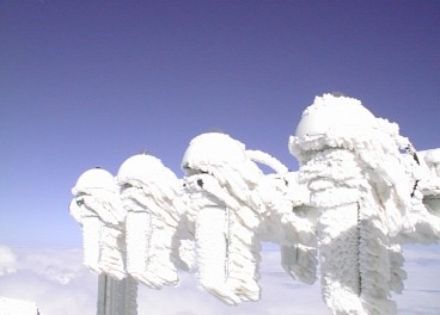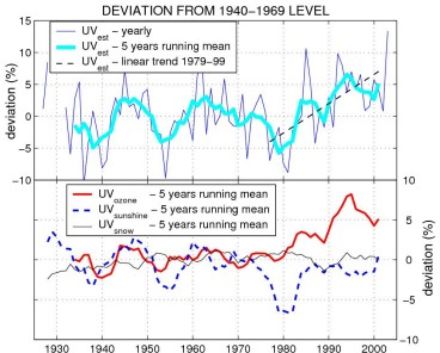Service Navigation
Search
Ultraviolet radiation has strong effects on human health, ecosystems and materials; assessing its intensity at the surface is important. A potential increase in UV radiation due to ozone depletion has raised concerns. Enhanced UV exposure also results from changing patterns in population activities (e.g., recreational open-air activities) and the popularity of sun tanning. Because UV measurements are scarce, a European effort (COST 726) was pursued for improving estimates of ground UV radiation based on environmental condition observations.
Observation records not sufficient to understand UV evolution
Routine operation and maintenance of UV radiation measuring instruments presents significant challenges and reliable data records are scarce. Furthermore, very few of them span more than one decade. It restricts studies aimed at understanding past UV changes and limits the possible investigations of the UV effects on health, ecosystems and materials.
In Switzerland, continuous monitoring of UV radiation is performed at four stations of the MeteoSwiss SACRaM network using broadband UV erythemal radiometers. Two stations are located in the Alps at Davos and the Jungfraujoch, and the others are located in the plains on the north and south side of the Alps (Payerne and Locarno-Monti). The first SACRaM station to start continuous UV monitoring was Davos in May 1995.

UV estimation based on proxy data can provide missing information
A technique called UV reconstruction was developed for supplementing the lack of UV observational records by estimating UV ground radiation using semi-empirical models and proxy data indicating the level of the most influential parameters for UV (typically, atmospheric ozone content, cloudiness and surface reflectivity or albedo). While UV measurements are scarce, it is possible to find information with better spatial coverage and of longer time span for these proxy parameters. Such methods allow inferring the amount of UV radiation at time when, or locations where, direct measurements are not available. The COST action 726 compared many such techniques.
COST-726: a European initiative for determining the climatology of UV radiation
COST action 726 aimed at "advancing the understanding of UV radiation distribution under various meteorological conditions in Europe in order to determine the UV radiation climatology and assess UV changes over Europe". The main achievement of the action was building a European climatology of UV daily doses (erythemal weighting) for the period 1958-2002. This climatology was validated with data from more than 10 measuring stations in Europe with reliable records. Observational data for UV radiation as well as environmental conditions influencing UV radiation were collected within Europe. The long term series of reconstructed UV radiation have been used for trend calculations and analyses, which investigated the sources of temporal variations in UV trend patterns over Europe. The climatology was built for erythemally-weighted UV. However, a lot of additional biological UV effects exist, for which the relevant biological action spectra have been collected in the COST action.

The climatology was derived based on UV reconstruction since reliable measurements were not available for the past 50 years. But the COST action put strong efforts into assuring future reliable UV measurements across European networks so that future research can be based on accurate measurements. Common quality control and maintenance procedures were established, and several large scale intercomparison and calibration campaigns were organized to calibrate reference radiometers used in national and regional networks. For more information see the COST 726 final scientific report.
The MeteoSwiss contribution to COST 726 devoted particular attention on cloudiness and surface reflectance (albedo), and methods have been devised for estimating their influence on UV radiation. An effective surface reflectance was derived from the amount of snow cover and used in model simulation of clear-sky UV radiation transfer. Concerning cloudiness, an empirical method was developed for inferring the effect of clouds on UV radiation based on measurements of the total solar short-wave (SW) irradiance. This method was developed because of the difficulty of theoretically modeling the influence of cloud on radiation transfer, and because SW irradiance has been measured at many locations in Switzerland since the 1980's. The cloud effects were investigated by assessing the relationship between cloud modification factors in the SW and UV. The cloud modification factor is the ratio between a real observed irradiance and the theoretical estimate of the irradiance in clear-sky situation. A semi-empirical all-sky model was designed and used for analyzing monthly trends of reconstructed UV irradiance at Davos, Jungfraujoch, Locarno-Monti and Payerne.
Reconstructing the world-longest time series of UV doses
The UV evolution was reconstructed in the region of Davos and Arosa using total ozone column, sun duration and snow cover. At this location, these proxy data are available since 1926. The results show UV level variations of the order of 5-10% (for the yearly averages) throughout the whole period of the study. Most of the variation in the estimated UV level is explained by the changes in total ozone column and sunshine duration (linked to cloudiness), while the influence of variations in the snow cover is minor. Variations prior to 1980 are to a large extent due to changes in cloudiness, while the main reason for the increasing UV level since the late 1970s is the diminution of the total ozone column.

Applications:
- Lindfors, A., and L. Vuilleumier (2005), Erythemal UV at Davos (Switzerland), 1926-2003, estimated using total ozone, sunshine duration, and snow depth, J. Geophys. Res., 110, D02104, doi:
10.1029/2004JD005231 - Global solar UV index, a Practical Guide (publication from WHO)
- Walker, D: 2010, Cloud effects on erythemal UV radiation in a complex topography, Veröffentlichungen der MeteoSchweiz, 86, 106 pp